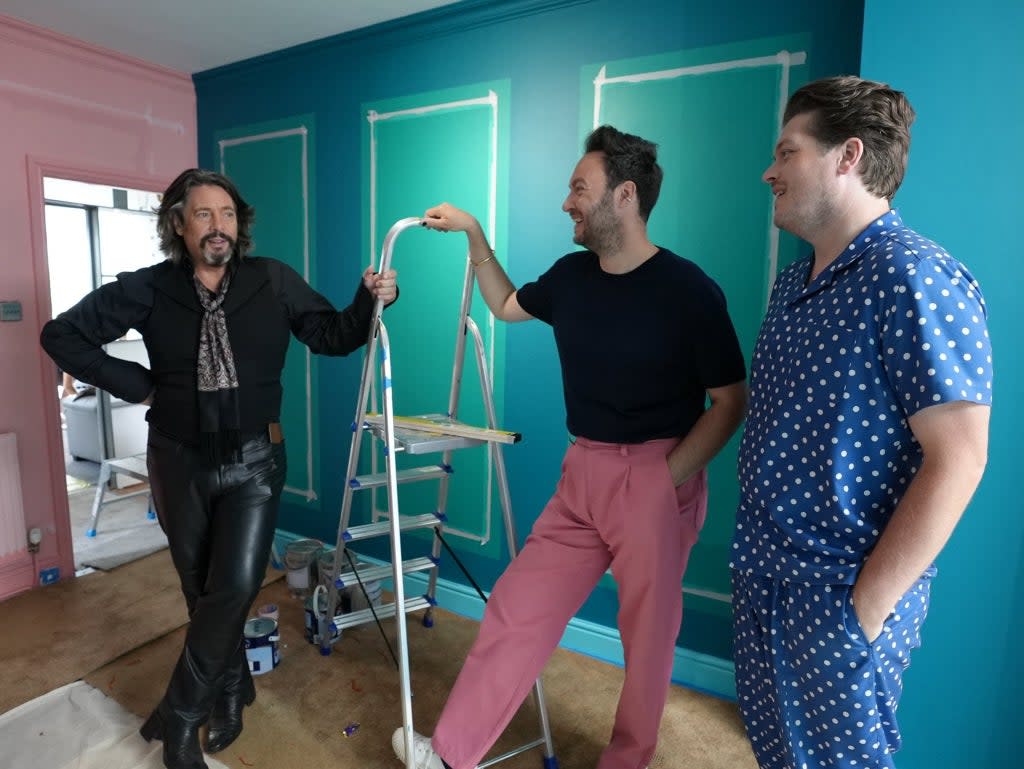From teapot disasters to walls of hair: How Changing Rooms became a beacon of mad optimism in a terrible world

Twenty-one years ago, a catastrophe unfolded on television that devastated the nation. The show was Changing Rooms, the proudly low-budget makeover series in which two sets of friends swap keys in order to renovate a room in each other’s homes, under the guidance of professionals.
In this instance, designer Linda Barker and her power tool-wielding sidekick “Handy Andy” were redecorating a room that would house the owner’s beloved collection of antique teapots. Barker had been asked to create a corner cabinet for maximum protection. Instead, she fashioned a “floating” display unit that, suspended from the ceiling, would show off the ceramic masterpieces in all their three-dimensional glory.
You can guess what happened next; in fact, you can watch the clip on YouTube, which is aptly titled Linda Barker’s Teapot Disaster. We see the team enter the room to find the shelves collapsed and the teapots smashed to pieces. As they survey the wreckage, you can hear one of the owners’ friends cry-laughing outside.
Now, after a 17-year break, the critically derided, heirloom-destroying series is back. In the era of prestige TV and a smorgasbord of channels and streaming platforms, you might wonder if its cocktail of boggling colour combinations, shonky MDF creations and crap stencilling would be too basic to make any impact. Wonder no more. Not only have contestants lined up to take part but, egged on by social media, viewers are lapping it up.
The reboot catapults us back to its brilliantly bonkers golden age, even though former presenter Carol Smillie has been replaced by Anna Richardson, best known for casting a critical eye on the nation’s nether regions as presenter of Naked Attraction. The series heralds the return of the curious phenomenon that is Laurence Llewelyn-Bowen – a wise move since he was always the main draw. This is a man who long ago learnt never to apologise for his crimes against interior design, and who discusses what he does as if it were a mystical calling rather than a job putting up gaudy wallpaper in suburban semis. The march of time has not dimmed the designer’s love of outré outfits. Here, he appears in leather trousers and matching leather waistcoat in a look that is part dandy highwayman, part sex dungeon captive.
Changing Rooms was, in its first incarnation, a staple of late Nineties/early Noughties television, the kind of anaesthetising early-evening fare that served as grout in the schedules before the more serious viewing got going. It was instantly popular, coinciding with a steep rise in home-ownership among twenty and thirtysomethings and the growing conviction that being surrounded by the shagpile carpets and magnolia walls of yesteryear was no way for anyone to live.
At its peak, the series attracted an audience of 12 million.
Ultimately, though, it outstayed its welcome. The format became repetitive, the designers increasingly arrogant and the renovations ever more cynically deranged. It became a place not just of smashed teapots but shattered dreams, with many contestants visibly devastated by the so-called upgrade. Among the stand-out monstrosities were an indoor water feature; a bedroom sculpture of a bare bum; an upside-down indoor tree; and a four-poster bed flanked with MDF cut-outs of Greek nudes. The nudes were later re-homed in the owners’ tortoise sanctuary.
That Changing Rooms should reappear at a time when property prices have skyrocketed and getting on the housing ladder is a pipe dream for anyone without a trust fund might seem weird. But we are nonetheless hooked. Why? Perhaps because it’s a beacon of mad optimism in a terrible world, and because it reminds us of more innocent times when lives were being ruined by a paint job rather than a pandemic. It also allows us to look at our own homes anew – homes that many of us have been stuck living and working in for 18 relentless months –â¯and think about the ways they could be cheered up, and the many ways they could be made worse.

Llewelyn-Bowen’s design preferences, along with those of newbie designers Jordan Cluroe and Russell Whitehead, and carpenter Tibby Singh, now bring with them a rush of nostalgia. In 2021, stencils, spray paints, MDF partitions and homemade “art” still abound. Ever impervious to the demands of practical living, Llewelyn-Bowen instals a swing seat in a bijou living room. For an owner to express a dislike of a particular colour remains a red rag to a bull. Hate the colour brown? Well, you’d better keep schtum if you don’t want your bedroom to be painted every shade of mud.
While there will be more design “innovations” to come, the pièce de résistance thus far has been Jordan and Russell’s hair art. Yes, that’s right –â¯hair stuck on a wall. An actual wall of hair. It is creepy and revolting but it is also a masterstroke, effortlessly setting social media alight. Changing Rooms lives on, new but reassuringly the same. Admit it – it’s really kind of great.
Read More
‘The Masked Singer got me my record deal’: How celebrities took over reality TV and won
The Dyer Strait: how Danny plots a course to our hearts
Alan Partridge is meant to be a sexist, delusional dinosaur – so why is he still so relevant?
Billy Crudup interview: ‘Pouting is not the future’
Why did male adolescents become cultural whipping boys?
Columbo at 50: How Peter Falk’s shambling detective became an enduring TV icon

 Yahoo News
Yahoo News 
